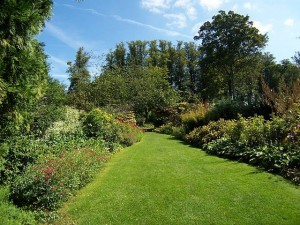The recent announcement that next season will be the last time viewers can catch up with Lord Grantham and the Crawley family caused consternation among Downton Abbey’s loyal fans.

Downton Abbey is the most successful program in the history of PBS broadcasting. In 2013, NBC Universal, owner of Carnival Films, estimated that worldwide, over 120 million viewers tuned in from over two hundred countries and regions. Season 1 came to the United States in 2011. The premier episode of Season 5 drew fifteen million viewers.
It’s not the first time Americans have been mesmerized by Edwardian households. Upstairs-Downstairs, one of the first PBS Masterpiece Theater series, ran from 1971-1975. It was black and white, and featured a townhouse rather than a grand estate, but the essential elements were all there. What was life like in the drawing room and servants’ hall?
HIGHCLERE CASTLE


Downton Abbey brought an added ingredient to the mix – Highclere Castle. I suspect few people fantasized about living at 165 Eaton Place with the Bellamys, but to live life on a 6,000 acre property forty-five miles outside London has a sort of universal appeal. Anyone with an extra $113 million can buy a similar home. But, you know what they say. If you have to ask the price, you probably can’t afford it. Buying a stately home is nothing compared to the cost of running it – a minimum of $808,178, annually.
Highclere Castle, for example, occupies 30,000 square feet with three hundred rooms, and is currently maintained by a fluctuating staff of sixty to one hundred fifty persons. These include gardeners, household staff, electricians, carpenters, tour guides, and staff for the tearoom and souvenir shop.
Perhaps you could live more modestly with a staff of seventy, including the butler, cook, gardeners, and cleaners. The smaller staff would still run about $594,880, annually.
But wait, there’s more. Highclere Castle has one hundred seventy single-glazed windows. Lacking insulation, these windows are not fuel-efficient. The National Trust estimated the cost of heating a generic stately home would be about $74,360 for heating oil and $52,052 for electricity.
Highclere Castle has thirty bathrooms (which seems sufficient for sixty bedrooms). The water bill would be at least $14,872 per year.
Maintenance for a structure built in 1842 is constant and expensive. In 2010, or thereabouts, Julian Fellowes, a friend of the family, selected Highclere Castle as the site for the Grantham family estate. Before filming could begin, over $17 million in essential repairs had to be made.
In fact, the house had reached such a state of disrepair the current Earl of Carnarvon was living in a cottage on the estate. But those days are over. Thanks to the success of Downton Abbey, the number of visitors to the property paying £20 (US$30) per ticket has increased to the point that reserved tickets are a “must.” The present Earl and his countess are very entrepreneurial in terms of offering their property to as many clients as possible. The castle is available for weddings, corporate events, and private dining. You can even rent a cottage on the grounds.
Seeing the real sets of Downton Abbey is only one of the reasons to visit Highclere Castle. More on the colorful Earls of Carnarvon in next week’s blog.
Acknowledgements:
Featured Image: Highclere Castle by JB + UK_Planet. Creative Commons Attribution. Wikimedia Commons
Downton Abbey Official Site. Here.
Highclere Castle. Here.
Lianna Brinded. “Downton Abbey: Astounding Cost of Crawley Family’s Lavish Lifestyle at Highclere Castle.” International Business Times. Dec. 18, 2014. Here.
Jeremy Egner. “A Bit of Britain Where the Sun Still Never Sets.” The New York Times. Jan. 3, 2013. Here.
Dave Itzkoff. “’Downton Abbey’ Will End After Next Season.” The New York Times. March 26, 2015. Here.
Loren King. “For ‘Upstairs Downstairs’ fans, ‘Downton’ brings on déjà vu.” The Boston Globe. Jan. 2, 2014. Here.
John Rabon. “The Real Downton: 10 Interesting Facts and Figures.” Jan. 13, 2015. Here.

Sandra Wagner-Wright holds the doctoral degree in history and taught women’s and global history at the University of Hawai`i. Sandra travels for her research, most recently to Salem, Massachusetts, the setting of her new Salem Stories series. She also enjoys traveling for new experiences. Recent trips include Antarctica and a river cruise on the Rhine from Amsterdam to Basel.
Sandra particularly likes writing about strong women who make a difference. She lives in Hilo, Hawai`i with her family and writes a blog relating to history, travel, and the idiosyncrasies of life.


We have been entirely smitten in the past 4 seasons. In terms of the popularity, it just shows how desperate we are for good programming albeit with elaborate lifestyles!! Haha!!! Thanks for sharing!